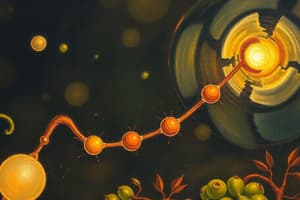Podcast
Questions and Answers
Which of the following metabolic pathways is correctly matched with its metabolic process?
Which of the following metabolic pathways is correctly matched with its metabolic process?
- Glycolysis - Anabolic
- β-oxidation of fatty acids - Catabolic (correct)
- Glycogenesis - Catabolic
- Gluconeogenesis - Catabolic
The rate-limiting enzyme in the Krebs cycle is aconitase.
The rate-limiting enzyme in the Krebs cycle is aconitase.
False (B)
How many ATP molecules are generated from one NADH molecule when it enters the electron transport chain at Complex I?
How many ATP molecules are generated from one NADH molecule when it enters the electron transport chain at Complex I?
2.5 ATP
During glycolysis, ATP is consumed in the energy-spending steps catalyzed by ______ and phosphofructokinase (PFK-1).
During glycolysis, ATP is consumed in the energy-spending steps catalyzed by ______ and phosphofructokinase (PFK-1).
Match the following processes with their primary outcome:
Match the following processes with their primary outcome:
Which of the following is a possible fate of pyruvate produced during glycolysis?
Which of the following is a possible fate of pyruvate produced during glycolysis?
Protein digestion begins in the mouth due to the action of gastrin.
Protein digestion begins in the mouth due to the action of gastrin.
What ion movement drives ATP synthesis through oxidative phosphorylation, and how does it facilitate ATP generation?
What ion movement drives ATP synthesis through oxidative phosphorylation, and how does it facilitate ATP generation?
During extended periods of fasting, the body primarily depends on ______ to produce energy.
During extended periods of fasting, the body primarily depends on ______ to produce energy.
Which of the following describes the role of FADH2 in the electron transport chain?
Which of the following describes the role of FADH2 in the electron transport chain?
Flashcards
Glycolysis
Glycolysis
The breakdown of glucose; it is a catabolic process.
Gluconeogenesis
Gluconeogenesis
The synthesis of glucose from non-carbohydrate precursors; it is an anabolic process.
Glycogenesis
Glycogenesis
The synthesis of glycogen from glucose; it is an anabolic process.
β-oxidation of Fatty acids
β-oxidation of Fatty acids
Signup and view all the flashcards
Citric Acid Cycle
Citric Acid Cycle
Signup and view all the flashcards
Acetyl CoA
Acetyl CoA
Signup and view all the flashcards
Energy spending steps in glycolysis
Energy spending steps in glycolysis
Signup and view all the flashcards
Pyruvate
Pyruvate
Signup and view all the flashcards
Glycogenesis
Glycogenesis
Signup and view all the flashcards
Functions of lipids
Functions of lipids
Signup and view all the flashcards
Study Notes
- Glycolysis is a catabolic process.
- Gluconeogenesis is an anabolic process.
- Glycogenesis is an anabolic process.
- β-oxidation of fatty acids is catabolic.
- The Krebs cycle is amphibolic.
- The citric acid cycle is the central hub and final common pathway, also known as the TCA cycle.
- Aconitase is the enzyme required for citrate to isocitrate conversion.
- Steps 3 and 4 in the Krebs cycle produce carbon dioxide and NADH.
- Isocitrate dehydrogenase is the rate-limiting enzyme in the Krebs cycle.
- Oxidative phosphorylation goes by another name.
- 4 protons are pumped in complex 1 of the electron transport chain (ETC) from the matrix to the intermembrane space.
- FADH2 enters the electron transport chain at complex II.
- The ATP yield of one NADH molecule when it enters the ETC is 2.5 ATP.
- The ATP yield of one FADH2 molecule when it enters the ETC is 1.5 ATP.
- Acetyl CoA is the gateway molecule that enters the Krebs cycle.
- Hexokinase and phosphofructokinase (PFK-1) are the energy-spending steps where ATP is used in glycolysis.
- Step 6 produces NADH in glycolysis.
- Pyruvate is the primary product of glycolysis.
- The net ATP yield during glycolysis is 2 ATP.
Fates of Pyruvate
-
Conversion to acetyl-CoA for entry to the Krebs cycle
-
Fermentation to lactate in anaerobic conditions
-
Fermentation to ethanol in yeast and some bacteria
-
The malate-aspartate shuttle transfers NADH into the mitochondrial inner membrane.
-
Glycogenesis is the formation of glycogen from glucose and reduced blood glucose.
-
Phosphatase enzyme removes a phosphate group from a molecule.
-
The pentose phosphate pathway is also known as the hexose monophosphate shunt.
-
4 protons are required to generate ATP molecules.
Functions of Lipids
-
Energy storage
-
Structural components
-
Insulation
-
Protection
-
An ester bond links glycerol to fatty acids.
-
Pancreatic lipase breaks down TAGs into free fatty acids and monoacylglycerol.
Order of Breaking Down Fatty Acids
-
FA activation
-
FA transport
-
Beta oxidation of FA
-
2 ATPs are spent in the activation of fatty acids.
-
Acyl CoA reacts with carnitine to form acylcarnitine.
-
Eicosanoic acid is the systematic name of arachidic acid.
-
Step 3 produces 1 NADH in β-oxidation of fatty acids.
-
Acetoacetate is an example of a ketone body.
-
Protein digestion starts in the mouth, and gastrin triggers the secretion of hydrochloric acid only is false.
-
H⁺: Moving through ATP synthase facilitates phosphorylation, which is how the ion drives ATP synthase and generates ATP during ATP synthesis through oxidative phosphorylation.
-
A peptide bond is the type of bond that links one amino acid to another.
-
Vitamin B6 is the active form of pyridoxal phosphate.
-
Ornithine and aspartate are substrates in the urea cycle.
-
Phenylalanine, isoleucine, arginine and lysine are essential.
-
The liver recycles lactate back to glucose and supplies energy to muscles
Liver Advantage in Cori Cycle
-
Recycles lactate back to glucose
-
Supplies energy to muscles
-
NADH donates electrons to complex I to initiate proton pumping in the electron transport chain
-
Oxidative phosphorylation uses a proton gradient to synthesize ATP.
-
A high blood glucose level triggers the release of insulin.
-
Acetyl-CoA is the initial substrate that supplies energy for the first reaction in the Citric Acid Cycle (Krebs Cycle).
-
The role of the liver to the Cori cycle from set 7 no. 1 is the same as question 46.
-
The nitrogen atom of degraded amino acids is ultimately excreted from the body in the form of urea.
-
ATP is the form of energy produced during glycolysis.
-
Disruption to a cell's mitochondrial membrane would stop or slow down the transport of electrons.
-
FADH2 in the electron transport chain transfers electrons to a lower energy complex in the ETC, affecting the amount of ATP produced.
-
Lactate dehydrogenase is responsible for the conversion of lactate back to pyruvate in the liver during the Cori Cycle.
-
Glucagon is administered to raise blood glucose levels and initiates glycogen breakdown specifically in the liver, but not in the muscle.
-
The liver stores the most glycogen.
-
Glucagon raises blood glucose by stimulating glycogen breakdown, particularly relevant to individuals with diabetes.
-
During extended fasting, triglycerides (TAGs) are oxidized through β-oxidation to form acetyl CoA, which then enters the citric acid cycle or contributes to ketone body formation as an energy source.
Studying That Suits You
Use AI to generate personalized quizzes and flashcards to suit your learning preferences.




